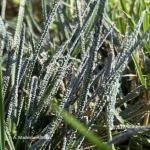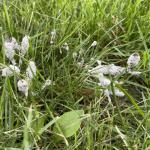The hot temperatures and abundant rains that have graced the area recently have created the perfect conditions for slime molds to do their thing. Despite the name, slime molds are not fungi but protozoans. They exist as single-celled organisms most of the time, living independently in the soil and reproducing by binary fission as long as bacteria (their favorite food) are abundant. When conditions are right, these independent cells produce hormones which cause them to aggregate, forming the complex visible structures we call slime molds. The purpose of this aggregation is the production of sexual spores, which are dispersed by wind.
There are over 900 species of slime molds worldwide and they come in an amazing array of different shapes and colors. They are common on turf but will form on the surface of any plant or organic matter (like mulch, another frequent setting) that is low to the ground. Their appearance can seem sudden and their striking looks may alarm homeowners. They do not cause disease in turf; however, turf blades may turn yellow because the slime mold on it is blocking the sunlight. Fortunately, these creatures are ephemeral and will dry out and vanish on their own in a few days. Light raking can hasten their disappearance, and the turf will soon green up.
Submitted by: Dr. Angela Madeiras

